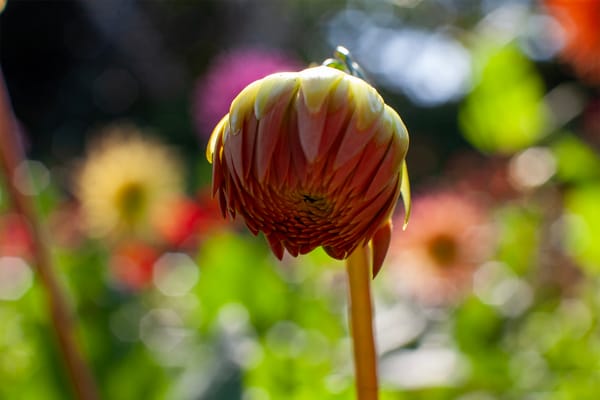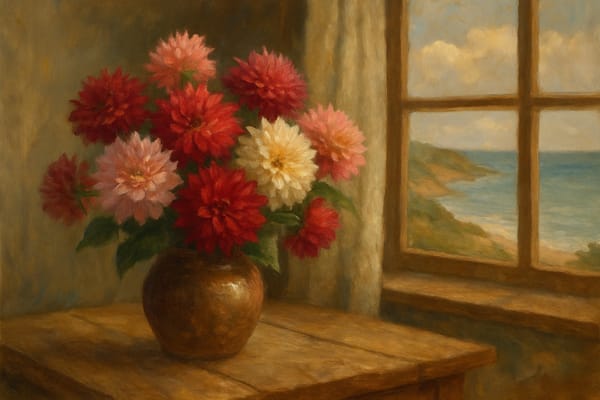In the soft light of a Cornish summer evening, there are few sights more joyful than a border alive with bees, butterflies, and the gentle hum of life. Among the vibrant blooms, dahlias—so often seen as purely ornamental—can play a surprising and valuable role in sustaining this garden ecosystem. When chosen and managed thoughtfully, dahlias become more than just a riot of color; they act as a bridge for pollinators and an integral thread in the biodiversity tapestry.
The Secret Life of Open-Centered Dahlias
Not all dahlias are created equal when it comes to wildlife value. The double-flowered showstoppers may win prizes on the show bench, but for pollinators, they’re often a closed door. Instead, it’s the open-centered dahlias—singles, collarettes, anemone-flowered, and the star-like “Honka” types—that offer a generous welcome.
Their accessible centers brim with nectar and pollen, drawing in honey bees, bumblebees, solitary bees, butterflies, hoverflies, and wasps. In particular, late summer and autumn, when native wildflowers are fading, sees open-centered dahlias providing critical forage, sustaining insect populations through seasonal gaps.
Recommended varieties include:
- Singles: ‘Twyning’s After Eight,’ ‘Waltzing Mathilda,’ ‘Happy Days’
- Collarettes: ‘Bishop of Llandaff,’ ‘Fashion Monger,’ ‘Pooh’
- Anemones: ‘Sandia Brocade,’ ‘April Heather’
- Honka Types: ‘Honka Fragile,’ ‘Honka Rose’
These cultivars not only attract pollinators but enrich the garden with a soft, naturalistic aesthetic, perfect for borders or cottage-style plantings.
Planting Plans with Wildlife in Mind
Dahlias thrive when interwoven with other nectar-rich plants. A layered planting scheme ensures a continuous flow of floral resources:
- Early Season: Native bulbs (crocus, snowdrops), pulmonaria, and wild primroses.
- High Summer: Open-centered dahlias mixed with cosmos, bee balm, verbena bonariensis, and echinacea.
- Late Season: Sedum (Hylotelephium), asters, single zinnias, and late-flowering rudbeckia.
Native grasses and perennial wildflowers like oxeye daisy or yarrow add structural diversity and attract predatory insects—nature’s pest control agents.
By mixing dahlias within this biodiverse matrix, gardeners create nectar corridors and dynamic habitats, supporting everything from pollinators to birds and beneficial beetles.
The Nuanced Impact on Native Bees
Open-centered dahlias offer a lifeline to generalist pollinators but are less critical for specialist native bees tied to specific wild plants. However, in urban and suburban settings—where floral diversity can be limited—dahlias help bridge forage gaps.
That said, the dynamics shift in areas with dense managed honey bee populations. Studies suggest that honey bees may outcompete native bees for floral resources, including dahlias. The key is balance:
- Integrate dahlias with a diverse range of native plants.
- Minimize chemical use and avoid pesticides.
- Maintain habitat features like bare soil, dead wood, and wild patches.
- Manage honey bee hive density if native bee conservation is a core goal.
Dahlias in the Wider Ecological Picture
Unlike some exotic ornamentals, dahlias are not considered invasive in most regions, including the UK. They rarely escape cultivation and do not threaten native plant communities. Their tuberous nature and seasonal dieback naturally limit spread.
However, gardens dominated solely by non-native ornamentals risk reducing overall ecological complexity. The ideal wildlife-friendly garden blends native perennials with adaptable ornamentals like open-centered dahlias. This approach sustains biodiversity while allowing gardeners to enjoy a broad palette of textures and colors.
Practical Wildlife Gardening with Dahlias
- Pest Control: Embrace natural methods—handpick slugs, use wool pellets, and attract predatory wildlife.
- Plant in Clusters: Group open-centered dahlias with other pollinator favorites to create easily found forage spots.
- Leave Blooms for Insects: Allow some flowers to remain uncut, providing feeding stations.
- Water Wisely: Mulch and deep water to promote strong, healthy plants that support longer flowering.
- Observe and Adapt: Watch which insects visit your dahlias and adjust companion planting to suit your local pollinator population.
A Cornish Perspective: Dahlias as Part of the Living Garden
In Cornish gardens, where Atlantic weather and rich horticultural heritage meet, dahlias fit beautifully into wildlife-conscious designs. Whether tucked among cottage garden classics or dancing in naturalistic borders alongside sea thrift and wild carrot, their vivid presence can support both ecological goals and visual delight.
By choosing open-centered varieties, integrating native flora, and gardening with nature’s rhythms, dahlias transform from ornamental afterthoughts to vibrant contributors in a living, breathing landscape.











